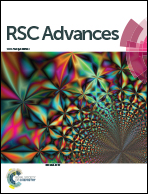Study of the pore structure and size effects on the electrochemical capacitor behaviors of porous carbon/quinone derivative hybrids†
Abstract
We demonstrate the hybridization of a redox-active quinone derivative, 2,5-dichloro-1,4-benzoquinone (DCBQ), and porous carbons with different pore structures for aqueous electrochemical capacitor electrodes. The hybridization is performed in the gas phase, which enables accurate porous carbon/DCBQ weight ratios. This method is advantageous over conventional liquid phase adsorption, in terms of facile optimization of the porous carbon/DCBQ weight ratio to obtain high-performance aqueous electrochemical capacitor electrodes, dependent on the kind of porous carbons; moreover, complete adsorption in the liquid phase cannot be achieved by the conventional liquid phase adsorption method. Their electrochemical capacitor performances are evaluated using an aqueous 1 M H2SO4 electrolyte, and the adsorbed DCBQ undergoes redox reactions inducing pseudocapacitance within the pores of porous carbons. To study the effect of the pore size on the electrochemical capacitor behavior, two kinds of activated carbon (AC) with different pore sizes are examined: the microporous AC and the AC with both micro- and mesopores. Additionally, we examine ordered microporous carbon with a uniform pore size of 1.2 nm and a three-dimensionally (3D) ordered and mutually connected pore structure. The results reveal that mesopores facilitate proton conduction inside the DCBQ-constrained carbon pores, whereas the 3D-ordered and mutually connected micropores balance high volumetric capacitance enhancement with excellent rate capability. Such high proton conduction inside such constrained spaces can be explained only by the Grotthuss mechanism.



 Please wait while we load your content...
Please wait while we load your content...